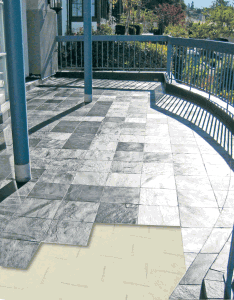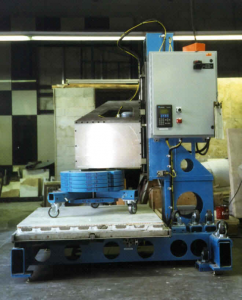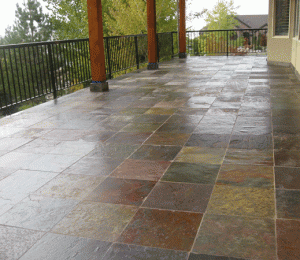USA: 1-800-338-3568 | CANADA: 1-866-591-5594
Tile Decks: Robinson Testing for Performance
Ceramic tile floor assembly testing is a valuable way of determining and measuring a (flooring) system’s performance prior to installation. While outdoor tile decks, particularly when over living space, have no specific testing criteria, testing the flooring assembly provides the peace of mind that the system is going to perform as intended in its real-world application. Duradek Tiledek under-tile membrane has been thoroughly tested in a ceramic tile floor assembly and can confidently offer a 10-year waterproofing guarantee.

Tile Floor Testing History
During the development of the thin-set method for installing ceramic tile back in 1958, Donald Robinson, the head of engineering research at the Tile Council Research Center, designed a testing machine to evaluate the performance of such a method on floors. Adopted as ASTM test method C-627 in 1970, the apparatus is commonly known as “The Robinson Floor Tester” and the ASTM C-627 is still used today as the benchmark for the performance of all types of flooring products.

Some technical consultants agree that the only problem with the Robinson Floor Tester is that it doesn’t necessarily give you the full picture since it is only a 4’ x 4’ pad the assembly is placed on, which may hinder the system from mimicking an entire floor installation.
Recognizing this, the Terrazzo, Tile and Marble Association of Canada (TTMAC) developed a more modern and advanced testing machine that can perform the ASTM C-627 for both conventional size test formats (4’ x 4’) or more real-life longer spans (up to 20’). Developed about nine years ago, the Universal Floor Tester tests assemblies following ASTM C-627 criterion and designates five levels of performance:
- Residential (three cycles)
- Light Commercial (six cycles)
- Moderate Commercial (ten cycles)
- Heavy Commercial (twelve cycles)
- Extra-Heavy Duty (fourteen cycles)

How Tile Floor Testing is Performed
The test requires a carriage with three wheels that rotate over the same path consistently with specific weights and a specific type of wheel designated for each cycle performed. Testing criteria is determined by being aware of what type of conditions under which the flooring will be used and then simulating those conditions.
The test assembly is placed under the carriage of the machine, and the first set of wheels, which are made of soft rubber, are installed along with steel plates weighing a total of 300 lbs. The cycle takes approximately one hour to complete 900 revolutions, and the load is continually increased by 150 lbs. for each cycle up to 900 lbs.
After each cycle, the technician inspects the assembly to see if any cracks, chips, loose tiles, etc. exist. If the assembly (the whole assembly system is observed for each cycle) is unaffected after four cycles, the wheels are changed to hard rubber and the process is repeated until there is evidence of failure or the eighth cycle is complete.
The final last two levels of performance require the use of steel wheels and to once again run the test through the increasing weights for each cycle. Once the test is completed or a failure is observed, the test is stopped and observations, readings, and pictures are taken. The final test classification is then determined and the testing technician provides a written report.
This test is extremely useful because it allows a simulated representation of what will occur at the installation site. In addition, you are able to test many types of material to demonstrate whether or not certain materials are able to work together.
Does Tiledek pass the Robinson Floor test?
Tiledek was tested to ASTM C627 (the Robinson Floor Test) on TTMAC’s Universal Floor Tester to see how suitable our system was for application under the tile. Tile has very little tolerance for any deflection or movement of the surface to which it is installed. Too much deflection or if the membrane beneath is too soft may cause cracking of the grout lines or the tile.
Tested over ¾ inch plywood and ½ inch cement board, Porcelain tile on Tiledek achieved a “Heavy” rating with no cracking of tile or grout lines after 9000 revolutions with 600 pounds on steel wheels (on the twelfth cycle). This is much more than would ever be necessary for residential traffic on a roof deck.
On the same subsurface assembly, Tiledek achieved a “residential” rating on slate. There were no signs of cracking on the slate or the grout lines. The failure was in the slate itself which showed signs of the surface deteriorating where the steel wheels made contact.
Builders and contractors may disagree on many things but there is one thing that most would agree on: Exterior tile projects are often ‘problem’ jobs. Duradek Tiledek hopes to change that perspective with the performance value of Tiledek under-tile roof membranes.
To learn more about Duradek Tiledek, check our blog each Monday in September as we publish a 4-part series detailing the specifics of Tiledek and tile installation methods.




